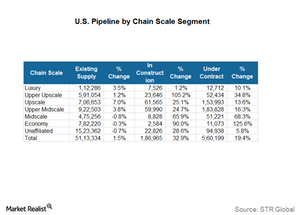Why Hotel Investors Should Follow Construction Pipeline Data
According to STR Global’s US Construction Pipeline Report for January 2017, rooms under contract rose 16.1% to reach 576,000 rooms in 4,763 hotel properties.
March 8 2017, Updated 9:06 a.m. ET

Construction pipeline
Hotel pipeline data reflect development activity in the hotel sector and point to future trends in supply. Hotels are classified into chain scale segments based on ADR (average day rate). It’s important for a hotel investor to understand which chain scale segments are expected to grow faster than others.
As most hotel chains operate largely in one or two segments, it helps for investors to identify which companies will grow faster than others. For example, Marriott International (MAR) operates in the luxury and upper-midscale segments, and Hyatt Hotels (H) mainly operates in the luxury and upper-upscale segments. Similarly, Starwood mostly operates in the upper-upscale and upscale segments, whereas Wyndham mostly operates in the midscale and upper-midscale segments.
Hotel pipeline in January 2017
According to STR Global’s US Construction Pipeline Report for January 2017, rooms under contract rose 16.1% to reach 576,000 rooms in 4,763 hotel properties. Rooms under contract include all projects in the planning and construction stages, but the metric doesn’t include projects that haven’t been confirmed. Rooms under construction in the United States also recorded a huge rise of 27.3% to 190,000 rooms under 1,449 hotel properties.
According to STR’s December 2016 report, for rooms under contract, the upper-midscale segment reported the highest number of rooms at 184,000, or 33%. The segment was followed by the upscale segment, which accounted for 154,000 rooms, or 27%. Despite having the lowest number of rooms under contract (2%, or 11,000 rooms), the economy segment recorded the highest growth rate of 125.6%.
Luxury hotels often take more time and capital to develop than full-service hotels, and developers appear to still be apprehensive about adding new supply. Investors can expect supply to catch up with demand mostly in the upper-midscale and upscale segments, given the growth in construction in these segments. Lower supply growth in the luxury and upper-upscale segments will help drive their occupancy and average daily rates.
You can get exposure to the hotel sector by investing in the First Trust Consumer Discretionary AlphaDEX ETF (FXD), which invests ~14.8% in the hotels, restaurants, and leisure sector. It holds 0.58% in Wyndham Worldwide (WYN), 0.87% in Hyatt, 0.90% in Hilton Worldwide Holdings (HLT), and 1.2% in Marriott.
